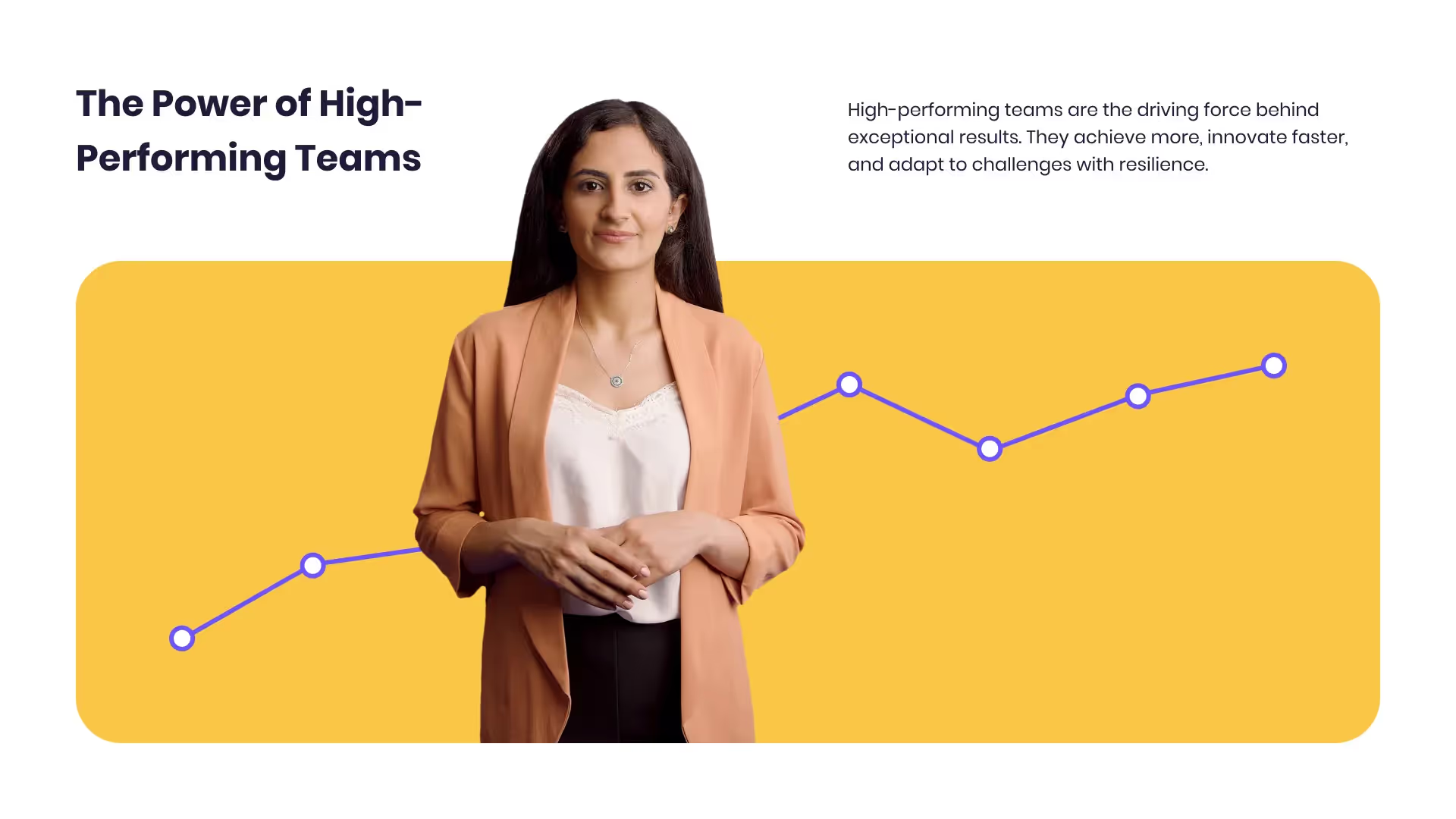Want a personalised avatar?
.avif)
Create an Instant Avatar in under a minute using your phone or camera. Fast, simple, and true to you.

Forklift Training Video: A Complete Guide to Safety Training


Introduction: Why Forklift Safety Training Matters
Forklifts are indispensable tools across many industries - including logistics, construction, manufacturing, and warehousing. These powerful machines boost productivity, move materials with ease, and keep supply chains running smoothly. However, they also pose serious safety risks. According to the Occupational Safety and Health Administration (OSHA), forklift-related accidents cause roughly 85 fatalities and 34,900 serious injuries in the U.S. each year.
The root cause? Inadequate training.
Forklift safety training is not just a regulatory requirement; it's a vital investment in your workforce’s well-being and your company’s long-term efficiency. Proper training reduces accident rates, cuts down on equipment damage, and helps avoid costly lawsuits or downtime. Yet traditional training methods - manuals, classroom lectures, and static slides - often fall short. They're time-consuming, disengaging, and hard to scale across teams or multiple locations.
Enter forklift training videos.
Well-designed forklift safety videos combine visual learning with real-world scenarios, helping workers retain crucial information. They can be standardized across teams, localized in different languages, and updated easily when regulations change. When created using tools like Colossyan’s AI video platform, these training materials can be produced quickly, affordably, and professionally - without the need for cameras or video crews.
In this comprehensive guide, we’ll walk through everything you need to know about forklift training videos - from regulatory requirements and video content planning to creation, deployment, and tracking. Whether you're in charge of corporate safety, L&D, or HR, this guide will help you streamline forklift safety education with modern, effective tools.
Understanding OSHA Forklift Training Requirements
Before diving into video production, it’s important to understand the legal and regulatory framework around forklift training. In the U.S., OSHA standard 1910.178(l) outlines the requirements for powered industrial truck (PIT) training.
Here are the key mandates:
- Training must be specific to the type of forklift and workplace conditions. This means if you use multiple models or work in different environments (indoor/outdoor), your training must reflect that.
- Operators must receive both formal instruction and practical training. Formal instruction can include videos, lectures, and written materials. Practical training involves hands-on operation.
- Evaluation is required. An employer must evaluate each operator’s performance before they are certified to operate a forklift.
- Refresher training must be provided:
- After any incident or near-miss
- When unsafe operation is observed
- If new equipment or conditions are introduced
- Every three years, at minimum
Understanding these requirements helps shape your training video content. You must ensure your video includes:
- Equipment-specific information (counterbalance, reach trucks, pallet jacks, etc.)
- Workplace-specific hazards (ramps, loading docks, narrow aisles, etc.)
- Best practices for inspection, load handling, and parking
Compliance is not optional. A well-structured training video can support OSHA standards by covering formal instruction in an engaging, repeatable format. Pairing the video with supervised practical training and documentation creates a complete safety program.
Benefits of Forklift Safety Videos vs. Traditional Training
Traditional forklift training often means classroom sessions, printed manuals, and maybe an instructor-led demo. While these methods can be effective, they’re not always practical - especially for distributed teams, shift-based workforces, or companies with high turnover.
Here’s how forklift training videos compare:
1. Consistency Across Teams
Videos deliver the same message every time, ensuring all employees receive standardized training. This is crucial when multiple instructors may vary in delivery.
2. Time and Cost Efficiency
Creating a training video with Colossyan’s AI avatars takes hours - not weeks. You avoid the costs of hiring actors, renting equipment, or coordinating on-site filming.
3. On-Demand and Self-Paced Learning
Employees can watch videos anytime, repeat difficult sections, and learn at their own pace - ideal for busy teams.
4. Localization and Accessibility
With AI-powered translations and lip-syncing, your video can be adapted into different languages and dialects to support global teams.
5. Higher Engagement and Retention
Visual learning increases information retention by up to 65%. By incorporating animations, voiceovers, and real scenarios, videos hold attention better than static materials.
Real-World Example:
A logistics company operating warehouses in five countries used Colossyan to produce forklift training videos in seven languages. Completion rates improved by 40%, and incident reports dropped by 22% within six months.
Step-by-Step: How to Create a Forklift Training Video
Creating an effective forklift training video doesn’t require a film studio. With an AI-powered platform like Colossyan, you can produce professional, localized content in just a few steps.
Step-by-Step Guide:
- Define Learning Objectives
- What must the operator know by the end of the video?
- Align objectives with OSHA standards and internal safety policies.
- Write the Script
- Keep language simple and direct.
- Break it into logical sections: introduction, equipment overview, operation, safety checks, common mistakes, and emergency procedures.
- Choose Your AI Avatar and Style
- Select from professional avatars in uniforms or warehouse settings.
- Use on-screen text, visuals, and b-roll footage if available.
- Record or Upload Visuals (Optional)
- Include actual footage or images of your site, equipment, or branded materials.
- Translate and Localize
- Use Colossyan’s auto-translate feature to create versions in multiple languages with synced lip movements.
- Review and Approve
- Ensure content aligns with safety standards.
- Review with your safety or compliance officer.
- Distribute and Track
- Upload to your LMS, internal portal, or share via private links.
- Monitor who watched, completion rates, and quiz scores if integrated.
This approach keeps production fast and scalable while ensuring all safety and regulatory needs are met.
Overcoming Common Challenges in Forklift Video Training
While video training is effective, it’s not without challenges. Here’s how to anticipate and overcome them:
1. Keeping It Engaging
Boring videos lose attention quickly. Use avatars that speak naturally, insert real-world examples, and add interactive quizzes when possible.
2. Updating Content
Regulations and workflows change. With Colossyan, you can quickly edit a script, regenerate the video, and replace the outdated version.
3. Ensuring Practical Experience
Videos cover theory, not physical operation. Pair video training with supervised hands-on sessions for a complete approach.
4. Accessibility for All Learning Styles
Supplement videos with transcripts, downloadable checklists, and translated captions for maximum accessibility.
5. Tracking and Certification
Use an LMS or internal platform to track completions, store certificates, and schedule refreshers. This ensures compliance and audit readiness.
Example:
An HR team at a U.S.-based manufacturer used Colossyan to revamp outdated forklift training. They integrated the video into their LMS and added a 10-question quiz. The pass rate went up, refresher training was automated, and audit preparation time was cut in half.
Best Practices for Forklift Video Training Success
To get the most value from your forklift training videos, follow these best practices:
- Keep Videos Short and Focused
- Break longer content into bite-sized modules (3–7 minutes each).
- Use Real Scenarios
- Show actual warehouse environments and common risks.
- Repeat Key Safety Rules
- Reinforce the most important guidelines multiple times.
- Add Visual Aids
- Use diagrams, signs, and step-by-step animations.
- Encourage Questions
- Create a follow-up forum or discussion group for questions and clarifications.
- Use Data to Improve
- Analyze engagement and quiz data to identify knowledge gaps or sections that need revision.
- Combine with Other Modalities
- Use a blend of video, in-person practice, and written materials for full-spectrum learning.
These strategies ensure your training remains effective, scalable, and adaptable to future needs.
Conclusion: Future-Proofing Forklift Safety with AI Video
Forklift training is not just a box to check - it’s a core component of a safe and efficient workplace. As workforce dynamics shift and operational complexity grows, the demand for modern, scalable training tools is higher than ever.
AI video platforms like Colossyan are changing the game. They empower safety teams, HR managers, and L&D professionals to create compelling, multilingual, and compliant forklift training videos in record time. With no need for filming equipment, video editing skills, or production crews, even non-technical teams can take ownership of safety education.
Imagine onboarding a new warehouse team in a new country. Instead of scrambling for trainers and translators, you simply adapt your existing video with a new voice, language, and scenario - ready to deploy in hours.
With Colossyan:
- Training is faster and easier to scale
- Localization is automatic and accurate
- Updates take minutes, not days
Most importantly, your teams stay safer.
Forklift training videos aren’t just a smart investment - they’re a strategic advantage. They reduce risks, ensure compliance, and build a culture where safety is part of the workflow.
Ready to take the next step? Try building your own forklift safety video with Colossyan and transform your training program into a powerful, modern experience.

Networking and Relationship Building
Use this template to produce videos on best practices for relationship building at work.

Developing high-performing teams
Customize this template with your leadership development training content.

Course Overview template
Create clear and engaging course introductions that help learners understand the purpose, structure, and expected outcomes of your training.
Frequently asked questions
What are the benefits of using forklift training videos?

Forklift training videos offer several benefits, including increased accessibility, consistency in training content, enhanced engagement, and cost-effectiveness by reducing the need for physical training resources.
How can AI video platforms like Colossyan improve forklift training?

AI video platforms like Colossyan streamline video creation, allowing for quick production of customized, localized, and engaging training content. They make video creation accessible to non-technical teams and support rapid updates to training materials.
What challenges might companies face when implementing forklift training videos?

Common challenges include technical issues, ensuring content relevance, and maintaining engagement levels. These can be addressed by providing technical support, regularly updating content, and incorporating interactive elements.
How can companies ensure that their forklift training videos remain relevant?

Companies should regularly update their training videos to reflect new regulations, best practices, and operational changes. Gathering feedback from employees can also help identify areas for improvement.
What are some industry trends in forklift training videos?

Current trends include the use of virtual reality to simulate real-world scenarios, AI integration for personalized training experiences, and data-driven insights to assess training effectiveness and improve content.
Didn’t find the answer you were looking for?















%20(1).avif)
.webp)


